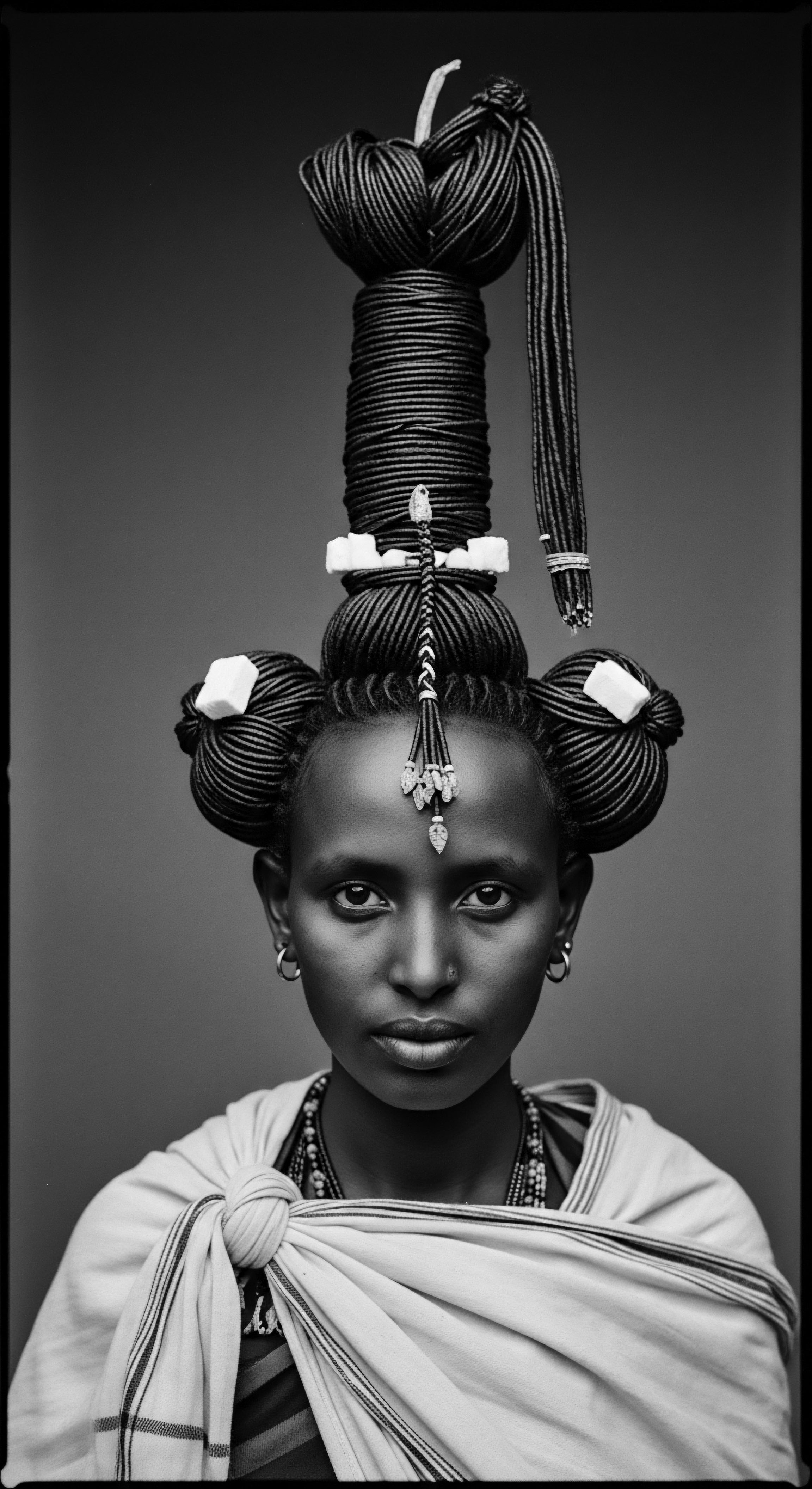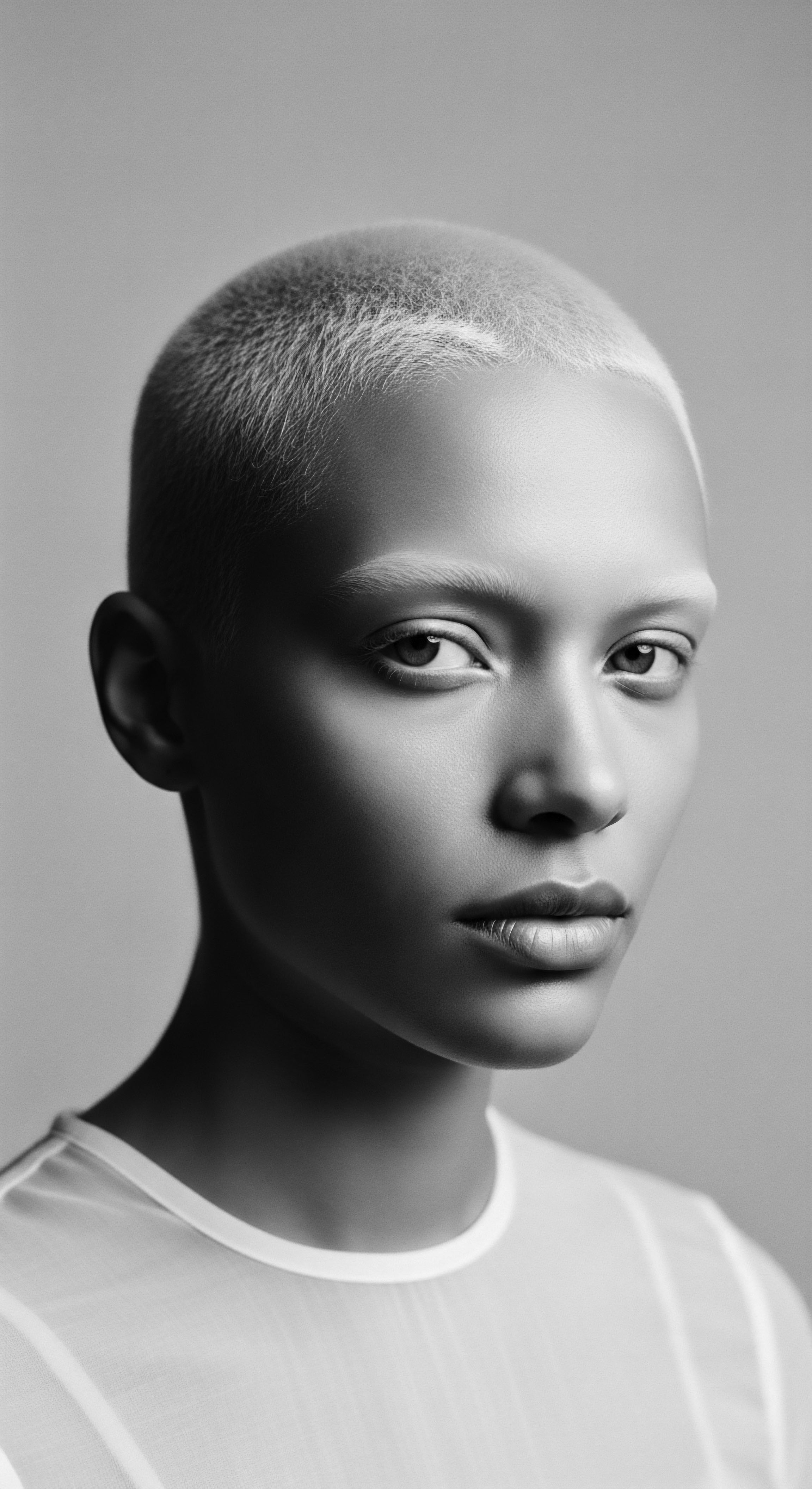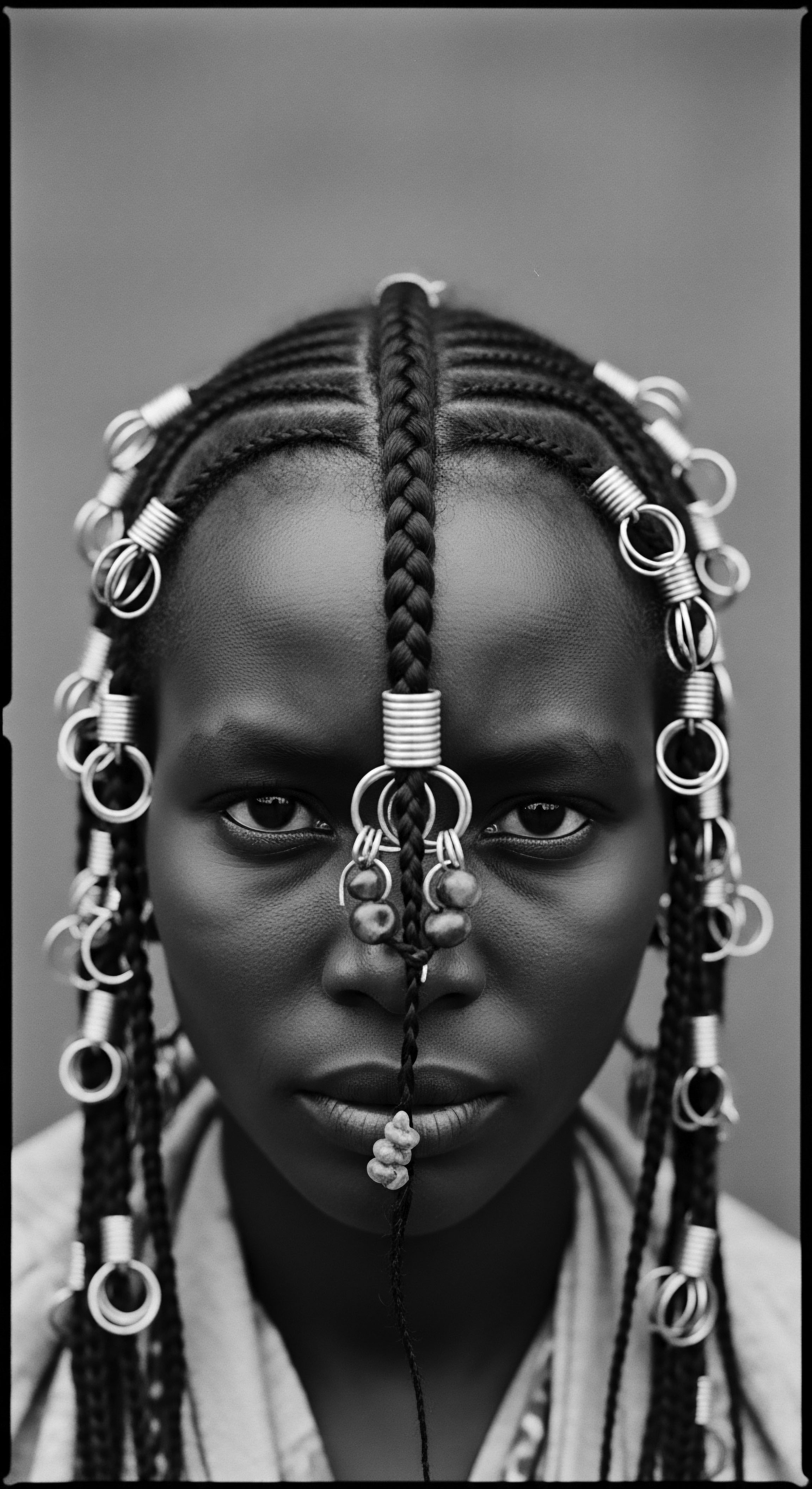The intricate relationship between African Black Soap and the delicate balance of textured hair is not merely a modern revelation; it is a narrative woven through centuries of ancestral wisdom, communal practice, and a profound respect for nature’s offerings. To truly understand how this traditional cleanser can aid in scalp equilibrium for hair with coils, kinks, and curls, one must first listen to the echoes from the source, tracing the heritage embedded within each dark, earthy bar. Our exploration seeks to honor this lineage, moving beyond simple product benefits to grasp the deeper cultural currents that have long guided the care of textured hair.

Roots
The story of African Black Soap, known by names such as ose dudu in Nigeria or alata simena in Ghana, begins not in a laboratory, but in the heart of West African communities. It speaks to a time when sustenance and self-care drew directly from the earth, fostering a symbiotic relationship between people and their environment. This traditional cleanser, far from being a singular, static entity, represents a living archive of localized ingredients and artisanal processes, passed down through generations of women who held the knowledge of plants and their restorative powers.
The making of this soap was, and often remains, a communal endeavor, a rhythmic dance of hands and hearth that binds families and villages in shared purpose. Its very creation embodies a philosophy of self-sufficiency and resourcefulness, transforming discarded elements like plantain skins and cocoa pods into a cleansing balm.

Ancestral Wisdom and Hair Anatomy
Before modern science meticulously dissected the hair shaft, ancestral communities understood textured hair with an intuitive depth. They perceived its inherent need for moisture, its tendency toward dryness, and the importance of a well-tended scalp as the literal ground for growth. These observations, honed over countless generations, led to sophisticated care rituals that instinctively addressed the unique anatomy of textured strands. A hair strand, particularly those with a tighter curl pattern, possesses a distinct elliptical or flat shape, with a cuticle that tends to be more open.
This structure, while allowing for magnificent volume and versatile styling, also means textured hair can lose moisture more readily than straighter counterparts. Maintaining the scalp’s delicate balance became paramount, preventing conditions that could hinder the expression of hair’s natural vitality.
African Black Soap embodies centuries of ancestral ingenuity, transforming natural elements into a cleansing balm for hair and skin.
The core ingredients of African Black Soap—typically including the ash of plantain skins, cocoa pods, palm leaves, or shea tree bark, combined with natural oils like palm kernel oil, coconut oil, and shea butter—are not accidental choices. Each component brings a legacy of specific properties. The ash provides the alkali necessary for saponification, the process by which oils transform into soap.
Yet, this is not the harsh lye of industrial soap; rather, it is a gentler, plant-derived potash. The natural oils, many of which are deeply emollient, temper the cleansing action, helping to mitigate the stripping effect often associated with conventional soaps.

Historical PH and Scalp Ecology
Consider the scalp as a thriving ecosystem, a microcosm of bacteria, fungi, and oils that coexist in a delicate equilibrium known as the scalp microbiome. Modern understanding tells us that a healthy scalp maintains a slightly acidic pH, typically between 4.5 and 5.5, which helps to keep opportunistic microbes in check and the skin barrier intact. Traditional African Black Soap, in its purest form, often possesses an alkaline pH, ranging from 8.90 to 9.78.
This might seem counterintuitive to contemporary dermatological advice for scalp care. However, historical use reveals a different perspective.
Ancestral practices were not bound by scientific pH scales but by observed efficacy and sensory feedback. The deep cleansing provided by the soap effectively removes buildup of dirt, excess sebum, and residual traditional styling agents, which can otherwise impede follicle health and lead to discomfort. The antimicrobial properties inherent in the soap’s plant-derived constituents also contribute to a healthier scalp environment.
A study comparing traditional black soap with conventional medicated soaps found that the black soap exhibited a high level of antimicrobial activity, demonstrating greater zones of inhibition against various skin microflora, including Staphylococcus aureus and Escherichia coli. This suggests that while alkaline, the soap’s holistic composition could effectively manage conditions that disrupt scalp balance, particularly in climates where sweat and environmental factors contribute to microbial overgrowth.
The wisdom of ancestral application often involved subsequent steps that would naturally help restore balance, even if the pH was not explicitly measured. The frequent use of nourishing oils and butters, such as shea butter and palm oil, after cleansing would have provided lubrication and helped to re-establish the scalp’s protective lipid layer. This intricate dance of cleansing and restoration, passed down through generations, speaks to a complete hair care philosophy that recognized the scalp’s needs in a way that perhaps transcends singular scientific parameters.
Understanding the traditional names for African Black Soap provides a window into its cultural significance across West Africa.
- Ose Dudu ❉ A Yoruba term from Nigeria, directly translating to “black soap,” it highlights the soap’s characteristic color derived from the roasted plant matter.
- Alata Simena ❉ A Ghanaian term, sometimes referring to “pepper sellers’ soap,” a nod to the Yoruba traders who brought the soap-making tradition to Ghana.
- Sabulun Salo ❉ A name used by the Hausa people in Nigeria and Mali, indicating its widespread recognition and use across diverse ethnic groups.

Ritual
The application of African Black Soap for textured hair is more than a mere cleansing step; it is a ritual steeped in the traditions of ancestral care, a tender thread connecting generations. These practices, honed over centuries, address not only the physical needs of the hair and scalp but also the spiritual and communal dimensions of self-care within Black and mixed-race experiences. The rhythmic motions of washing, massaging, and preparing the hair become a meditative act, echoing the collective spirit of women gathering to tend to each other’s crowns. This shared heritage underscores the holistic approach to beauty, where health and spirit intertwine.

Traditional Practices and African Black Soap
Historically, communities across West Africa utilized African Black Soap not just for daily bathing but specifically for hair and scalp cleansing. Its efficacy lay in its ability to thoroughly purify, lifting away the accumulation of environmental impurities, natural sebum, and the residue of traditional pomades and styling agents. For textured hair, prone to product buildup due to its unique curl patterns and the need for frequent moisturizing, this deep cleansing was, and remains, essential.
The soap’s natural exfoliating properties, a direct result of the plant ashes in its composition, also play a role in promoting scalp clarity by removing dead skin cells that might clog follicles. This gentle exfoliation prevents the discomfort of an itchy scalp or flaking, common concerns for many with textured hair.
The versatility of African Black Soap also meant it was often adapted with local ingredients to suit specific needs or regional variations. Some traditional recipes incorporated honey for added moisture, or camwood (Pterocarpus osun) for its exfoliating benefits, transforming the basic cleanser into a more specialized treatment. These adaptations reflect a dynamic tradition of innovation within ancestral practices, where ingredients were thoughtfully selected from the surrounding environment to enhance the soap’s qualities.
The use of African Black Soap in hair care is a ritual, deeply rooted in ancestral wisdom that addresses both physical cleansing and communal well-being.
What role did ancestral knowledge of specific botanicals play in the perceived efficacy of African Black Soap for scalp balance? Traditional healers and custodians of knowledge understood the properties of the plants they used. For example, plantain skins, a common ingredient, are known to contain vitamins A and E, and iron, which historically were understood to contribute to overall skin and hair vitality.
Cocoa pods are rich in antioxidants and possess anti-inflammatory properties, offering soothing benefits to the scalp. These plant compounds, now validated by modern phytochemical studies, provided natural antimicrobial and anti-inflammatory support that helped keep the scalp clear and comfortable, even without precise scientific understanding of microbial communities.

Scalp Health and Textured Hair Care Regimens
African Black Soap’s contribution to scalp balance extends to its potential in managing various scalp conditions. Its antimicrobial and antifungal properties have been noted in research, suggesting its use in addressing issues such as dandruff and fungal infections, which can often plague textured hair due to moisture retention on the scalp and product layering. A healthy scalp, free from irritation and excessive microbial growth, provides the best foundation for hair to flourish.
For textured hair, the delicate balance between effective cleansing and preserving natural moisture is constant. African Black Soap, with its inherent unsaponified oils from ingredients like shea butter and coconut oil, offers a unique cleansing experience. Unlike many commercial shampoos that strip hair of its natural oils, black soap, when used mindfully, can cleanse without excessive dehydration, leaving behind some of the nourishing oils.
However, its alkaline pH means a follow-up with an acidic rinse (such as diluted apple cider vinegar) or a conditioning treatment is a customary and wise step to help close the cuticle and restore the scalp’s slightly acidic mantle. This two-step process, implicitly understood in traditional use, ensures that the scalp’s ecosystem is respected and maintained.
The historical context of textured hair care reveals a lineage of purposeful practices.
- Cleansing with Potash-Based Soaps ❉ Early forms of soap, including what we know as African Black Soap, were widely used to purify the scalp and hair, leveraging the cleansing power of plant ashes and natural oils.
- Oil Application After Washing ❉ Following cleansing, rich oils and butters were consistently applied to condition the hair, seal moisture, and protect the scalp from dryness, creating a comprehensive care ritual.
- Protective Styles for Preservation ❉ Intricate braiding, twisting, and threading techniques were not only aesthetic expressions but also served as protective measures, minimizing manipulation and preserving hair length and health.
| Traditional Ingredient (Source) Plantain Skins/Ash (West Africa) |
| Heritage Significance for Scalp/Hair Historically valued for cleansing and perceived restorative qualities; contributes to the soap's alkalinity for purification. |
| Modern Scientific Link for Scalp Balance Contains vitamins A & E; contributes potassium hydroxide for saponification. May assist in clarifying the scalp and removing buildup. |
| Traditional Ingredient (Source) Cocoa Pods/Ash (West Africa) |
| Heritage Significance for Scalp/Hair Used for its darkening properties and believed to cleanse and protect the skin. |
| Modern Scientific Link for Scalp Balance Rich in antioxidants, may possess anti-inflammatory and antimicrobial properties beneficial for soothing scalp irritation. Provides potash for saponification. |
| Traditional Ingredient (Source) Shea Butter (West Africa) |
| Heritage Significance for Scalp/Hair A cornerstone of ancestral skin and hair care, deeply prized for its moisturizing properties and protection against harsh environments. |
| Modern Scientific Link for Scalp Balance High in fatty acids and vitamins (A, E), providing profound moisture and emollience to the scalp, preventing dryness and supporting skin barrier function. |
| Traditional Ingredient (Source) Palm Kernel Oil / Coconut Oil (West Africa) |
| Heritage Significance for Scalp/Hair Traditional oils used for their nourishing effects on skin and hair, integral to the soap's texture and cleansing ability. |
| Modern Scientific Link for Scalp Balance Provide fatty acids for saponification and also contribute unsaponified oils that offer residual moisture and antimicrobial benefits to the scalp. |
| Traditional Ingredient (Source) This table illustrates the deep connection between traditional African Black Soap ingredients, their historical application, and contemporary scientific understanding of their benefits for scalp health within the rich heritage of textured hair care. |

Relay
The legacy of African Black Soap, as it pertains to scalp balance for textured hair, is a relay race across time, where ancestral wisdom passes the baton to modern understanding. This transmission of knowledge, often through oral traditions and communal learning, ensures that the profound insights into natural care continue to inform and inspire contemporary practices. The exploration of its efficacy demands a gaze that is simultaneously historical and analytical, honoring the ingenuity of its origins while applying the rigor of scientific inquiry. This deep appreciation for its cultural context provides a richer, more complete picture than any singular lens could offer.

Scalp Microbiome and Traditional Cleansing Practices
The scalp is an intricate ecosystem, teeming with microorganisms that collectively form the scalp microbiome. Maintaining its balance is fundamental to hair health, influencing everything from hydration to growth cycles. Modern research highlights that an imbalance in this microbial community can contribute to various scalp issues, including dandruff, itchiness, and inflammation.
African Black Soap, with its historical roots as a cleansing agent, offers a compelling interaction with this delicate environment. Its plant-derived components, particularly the ash from cocoa pods and plantain skins, possess inherent antimicrobial properties.
A significant aspect of African Black Soap’s historical use for scalp balance lies in its ability to provide a deep cleanse without the harshness of many early synthetic soaps. While its alkaline pH (ranging often from 8.9 to 9.78) might raise concerns in a purely Western dermatological context that favors slightly acidic products for the scalp, the soap’s natural glycerin content and the presence of unsaponified oils (from shea butter, palm oil, coconut oil) act as emollients, preventing excessive stripping of the scalp’s protective lipid barrier. This balance is critical for textured hair, which is inherently more prone to dryness.
Consider a study by Ikpoh et al. (2012), which compared the antimicrobial activities of locally made black soap with several conventional medicated soaps against various human skin microflora. The findings revealed that traditional black soap exhibited a “high level of antimicrobial activities resulting in greater zones of inhibition (10.65)” compared to medicated soaps like Dettol (7.58) and Dudu Osun (9.78), among others. This evidence suggests a scientific basis for the historical reliance on black soap for maintaining scalp hygiene and addressing conditions linked to microbial imbalance, a critical component of scalp health for all hair types, particularly textured hair.
The study also posited that these antimicrobial properties stem from the soap’s phytochemicals. This research validates ancestral knowledge through a scientific lens, confirming that the natural compounds within African Black Soap contribute meaningfully to a balanced scalp environment.
The deep cleansing and inherent antimicrobial properties of African Black Soap, rooted in its natural composition, support a balanced scalp environment.

The PH Paradox and Traditional Countermeasures
The inherent alkalinity of African Black Soap, while effective for cleansing, necessitates a nuanced approach, especially for textured hair. Ancestral practices instinctively countered this. After cleansing, it was common to apply nourishing oils and butters, which not only moisturized the hair strands but also helped to restore the scalp’s lipid barrier and potentially lower its pH. This traditional understanding of sequential care, where cleansing is followed by replenishment, is a testament to the comprehensive nature of ancestral hair rituals.
Modern science now validates the importance of this follow-up ❉ post-cleansing acidic rinses or conditioning treatments are recommended to help rebalance the scalp’s pH and seal the hair cuticle, minimizing dryness and enhancing manageability. This synchronicity between ancient wisdom and contemporary understanding speaks to an enduring truth about textured hair care.

What does Contemporary Research Tell Us about African Black Soap and Scalp Health?
Modern scientific inquiry, while sometimes highlighting the alkaline nature of traditional black soap, largely supports its efficacy in cleansing and promoting scalp health due to its natural composition and antimicrobial properties. Studies point to its effectiveness in reducing buildup and addressing microbial imbalances, underscoring the wisdom of its long-standing use for dermatological conditions. Researchers continue to explore the specific phytochemicals responsible for these observed benefits, bridging the gap between traditional knowledge and modern pharmaceutical understanding.

From Elemental Biology to Ancestral Practices
The journey of African Black Soap from its elemental components to its role in nurturing textured hair is a testament to adaptive brilliance. The carefully chosen plant materials, roasted to create potassium-rich ash, combine with oils in a traditional saponification process that retains the natural glycerin, a humectant. This process, often undertaken communally, yields a product that cleanses without the harshness of modern detergents, which can strip precious moisture from textured strands. The tactile experience of using African Black Soap, often with its characteristic rough texture, also serves as a gentle mechanical exfoliant, aiding in the removal of dead skin cells and product residue that might otherwise hinder scalp breathing and hair growth.
The continued adoption of African Black Soap within textured hair communities globally is not merely a nostalgic return to tradition; it is a conscious choice, driven by the desire for authentic, natural solutions that respect the unique needs of curls, coils, and kinks. It represents a living connection to heritage, a tangible link to the practices that sustained vibrant hair health through generations. The insights from ancient wisdom, now often validated by scientific inquiry, affirm African Black Soap’s enduring place in the story of textured hair care.

Reflection
The enduring story of African Black Soap and its deep connection to scalp balance for textured hair is a powerful echo of heritage, a testament to the living archives held within Black and mixed-race hair traditions. It reminds us that wisdom often resides in the ancient rhythms of daily life, in the earth’s generous offerings, and in the hands that meticulously craft and apply them. This is a narrative that transcends mere product efficacy; it speaks to identity, resilience, and the profound beauty of ancestral ingenuity.
Each strand of textured hair carries the echoes of countless generations, a helix unbound by imposed standards, always reaching for its authentic expression. The deliberate choice to incorporate African Black Soap into one’s care regimen is a conscious act of reclaiming and honoring this lineage. It is a recognition that the foundational principles of cleansing, nourishment, and balance were understood and practiced long before scientific instruments measured pH levels or identified microbial communities.
This holistic approach, passed down through the tender threads of familial and communal ritual, cultivates not only healthy hair but also a deeper connection to self and history. The continuous exploration of African Black Soap’s role in modern hair care is a bridge between past and present, a quiet revolution in nurturing textured hair that finds its truest voice in the wisdom of its roots.

References
- 1. EcoFreax. (2023, August 24). African Black Soap ❉ The Natural Wonder for Skin and Hair.
- 2. Wikipedia. African black soap.
- 3. Emejulu, C. L. Onyeagba, R. A. & Ugbogu, O. C. (2016, May 29). Comparative studies on the effect of locally made black soap and conventional medicated soaps on isolated human skin microflora. ResearchGate.
- 4. Global Mamas. African Black Soap.
- 5. Kouassi Kustoms. (2024, May 20). Secrets of Artisan African Black Soap ❉ Ingredients and Benefits.
- 6. Emejulu, C. L. Onyeagba, R. A. & Ugbogu, O. C. (2016). Comparative studies on the effect of locally made black soap and conventional medicated soaps on isolated human skin microflora. Request PDF.
- 7. Nku Naturals. (2023, November 16). African Black Soap Hair and Scalp Treatment.
- 8. Daolus Organic Products. RAW BLACK SOAP POWDER.
- 9. Bramble Berry. The History of African Black Soap.
- 10. The Love of People. (2023, November 17). 9 Benefits Of African Black Soap For Hair.
- 11. Why African Black Soap Shampoo & Conditioner Are Changing the Haircare Game. (2025, May 14).
- 12. Africa Imports. Traditional African Secrets For Long And Healthy Hair.
- 13. Unique Aromas. African Black Soap.
- 14. Sellox Blog. (2021, June 4). Ancient African Hair Growth Secrets For Healthy Hair.
- 15. Dermatology, J. of C. A. (2023, November 30). What Every Dermatologist Must Know About the History of Black Hair.
- 16. Colomas, J. (2023, December 2). Unlock Ancient Hair Care Secrets ❉ Discover Global Rituals for Lustrous Locks.
- 17. The Real Science Behind African Black Soap Shampoo for Hair Growth. (2025, May 13).
- 18. Bebrų Kosmetika. (2024, August 23). The Power of Hair in African Folklore ❉ Rituals and Traditions.
- 19. African Beauty and Skincare ❉ A Deep Dive into History, Traditions, and Natural Ingredients. (2025, January 16).
- 20. Obscure Histories. (2024, February 13). Ancient Gems ❉ A Historical Survey of African Beauty Techniques.
- 21. Youtube. (2023, March 30). Ancient African hair growth secrets that EASILY grow healthiest longest natural hair.
- 22. A comparison of the antibacterial activity of some African black soaps and medicated soaps commonly used for the treatment of bacteria-infected wound.
- 23. Baraka Shea Butter. (2024, July 9). 3 Benefits Of African Black Soap For Hair (Detailed).
- 24. YouTube. (2021, December 5). Shocking results!! I USED AFRICAN BLACK SOAP TO WASH MY 4b/ 4c NATURAL HAIR AND THIS HAPPENED.
- 25. Owolabi, K. A. Bello, T. O. & Owolabi, B. J. (2024, December 9). African Black Soap; Physiochemical, phytochemical properties and uses. Request PDF.
- 26. Lin, J. et al. (2017, July 1). Discovering Black Soap ❉ A Survey on the Attitudes and Practices of Black Soap Users. PubMed.
- 27. Premium Beauty News. (2024, July 3). Ancestral hair-paste ritual gains new life in Chad.
- 28. Sanca, G. M. B. et al. (2022, November). Black women’s hair ❉ the main scalp dermatoses and aesthetic practices in women of African ethnicity. PubMed Central.
- 29. Lin, J. et al. (2017, July 1). A Survey on the Attitudes and Practices of Black Soap Users. PubMed.
- 30. Hair Care Practices from the Diaspora ❉ A Look at Africa, America, and Europe. (2025, January 23).
- 31. Obscure Histories. (2024, February 13). Ancient Gems ❉ A Historical Survey of African Beauty Techniques.
- 32. CORE. VISUALIZING THE BODY ❉ PHOTOGRAPHIC CLUES AND.
- 33. Reddit. (2021, August 26). No raw oils and butters vs. Traditional African hair care? ❉ r/Naturalhair.
- 34. Cleveland Clinic Health Essentials. (2022, October 17). Benefits of Using African Black Soap.
- 35. ResearchGate. Fading, Twisting, and Weaving ❉ An Interpretive Ethnography of the Black Barbershop as Cultural Space.
